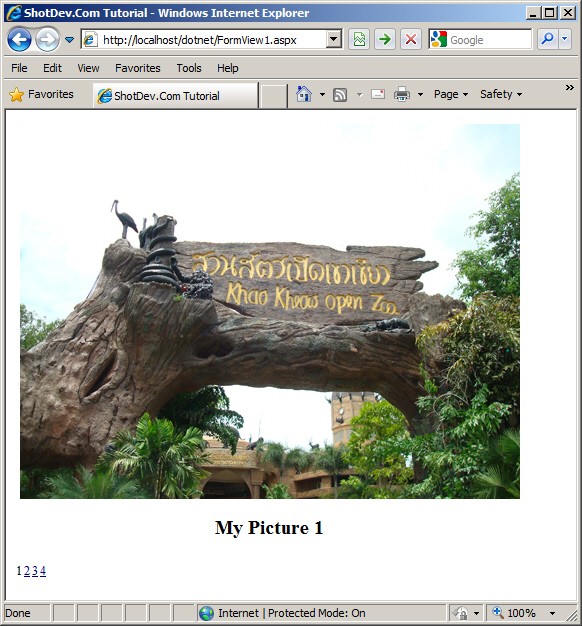ASP.NET(vb.net) & FormView - Oracle Database - System.Data.OracleClient Example scripts how to use FormView control in asp.net , Using Connector System.Data.OracleClient namespace is the .NET Framework Data Provider for Oracle, how to the connect to Oracle Database.
ShotDev Focus:
- ASP.NET(vb.net) & FormView - Oracle Database - System.Data.OracleClient
Example
FormView1.aspx
<%@ Page Language="VB" AutoEventWireup="false" CodeFile="FormView1.aspx.vb" Inherits="FormView1" %> <!DOCTYPE html PUBLIC "-//W3C//DTD XHTML 1.0 Transitional//EN" "http://www.w3.org/TR/xhtml1/DTD/xhtml1-transitional.dtd"> <html xmlns="http://www.w3.org/1999/xhtml" > <head runat="server"> <title>ShotDev.Com Tutorial</title> </head> <body> <form id="form1" runat="server"> <asp:FormView id="myFormView" runat="server" AllowPaging="True"> <ItemTemplate> <table width="500" cellpadding="5" border="0"> <tr> <td valign="top" align="center"> <asp:Image id="Image1" runat="server"/> <br /> <h2><asp:Label id="lblGalleryName" runat="server"></asp:Label></h2> </td> </tr> </table> </ItemTemplate> </asp:FormView> </form> </body> </html>
FormView1.aspx.vb
Imports System.Data
Imports System.Data.OracleClient
Partial Class FormView1
Inherits System.Web.UI.Page
Protected Sub Page_Load(ByVal sender As Object, ByVal e As System.EventArgs) Handles Me.Load
IF Not Page.IsPostBack() Then
BindData()
End IF
End Sub
Sub BindData()
Dim objConn As OracleConnection
Dim objCmd As OracleCommand
Dim dtAdapter As New OracleDataAdapter
Dim strConnString As String
strConnString = "Data Source=TCDB;User Id=myuser;Password=mypassword;"
objConn = New OracleConnection(strConnString)
objConn.Open()
Dim strSQL As String
Dim ds As New DataSet
strSQL = "SELECT * FROM gallery "
objCmd = New OracleCommand
With objCmd
.Connection = objConn
.CommandText = strSQL
.CommandType = CommandType.Text
End With
dtAdapter.SelectCommand = objCmd
dtAdapter.Fill(ds)
'*** BindData to FormView ***'
myFormView.DataSource = ds
myFormView.DataBind()
ds = Nothing
objConn.Close()
objConn = Nothing
End Sub
Protected Sub myFormView_DataBound(ByVal sender As Object, ByVal e As System.EventArgs) Handles myFormView.DataBound
'*** Image ***'
Dim Image1 As Image = CType(myFormView.FindControl("Image1"), Image)
If Not IsNothing(Image1) Then
Image1.ImageUrl = "images/" & myFormView.DataItem("Picture")
Image1.Attributes.Add("OnClick", "window.open('images/" & myFormView.DataItem("Picture") & "')")
Image1.Style.Add("cursor", "hand")
Image1.ToolTip = myFormView.DataItem("GalleryName")
End If
'*** GalleryName ***'
Dim lblGalleryName As Label = CType(myFormView.FindControl("lblGalleryName"), Label)
If Not IsNothing(lblGalleryName) Then
lblGalleryName.Text = myFormView.DataItem("GalleryName")
End If
End Sub
Protected Sub myFormView_PageIndexChanging(ByVal sender As Object, ByVal e As FormViewPageEventArgs) Handles myFormView.PageIndexChanging
myFormView.PageIndex = e.NewPageIndex
BindData()
End Sub
End Class
Create a asp.net file and save to path root-path/dotnet/
Run
http://localhost/dotnet/FormView1.aspx
Screenshot



1snapshot…
…